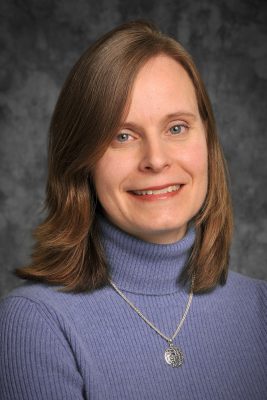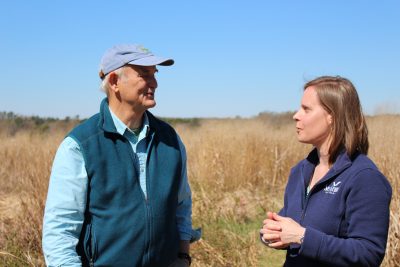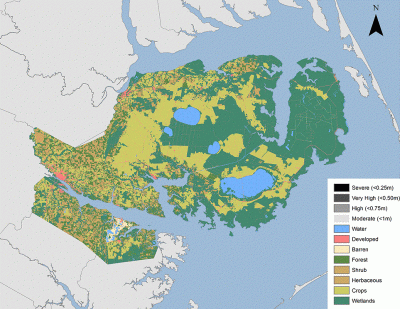Planets. Stars. The Moon. Oysters?
Space seems literally a world away from the ocean. So, what relation does space have to oyster reefs?
Supporter Spotlight

They have Susan White in common. As part of her job, she finds ways to bring technologies by the National Aeronautics and Space Administration to research the state’s coast.
She is the director of the North Carolina Space Grant and North Carolina Sea Grant, as well as the state’s Water Resources Research Institute, or WRRI. All three programs are based out of North Carolina State University.
White finds opportunities to use funds from federal agencies, including NASA and the National Oceanic and Atmospheric Administration, to bring research, education and outreach to North Carolina.
An even more interesting aspect of her job is to find ways for these resources to overlap. For the state’s coast, these means an innovative approach to research.
Managing Three Programs
White was named in October as the director of NC Space Grant after a stint as its interim director. The program is a consortium of 13 academic institutions that, in partnership with NASA, promote “aeronautics and space-related science, engineering, and technology education and training in North Carolina,” according to the program’s website.
Supporter Spotlight
White’s work with the space program adds to her list of leadership positions.
NC Sea Grant, where she is also director, is a program that manages millions of dollars of federal funds focused on providing research and outreach funding for the state’s coast, including shoreline restoration, fish management and coastal economic analysis.
White, in her leadership of WRRI, manages a program that receives funding from the United States Geological Survey to research freshwater and water supply in the state. Like the other two programs, WRRI also promotes outreach and education to the public.
“In certain ways, they are definitely distinct,” White said about the programs. “They have their own missions and subject areas, but in the way that I look at them, they are so interconnected. They are a comprehensive piece that makes sense for us to have administrated, sort of, centrally, under one group.”
White said her leadership roles were a continuous pathway because of her background in coastal ecology. WRRI and NC Sea Grant had just merged when she came on board as director. She previously worked at NOAA’s Hollings Marine Laboratory in South Carolina and for NOAA’s Estuarine Reserves Division and National Estuarine Research Reserve System.
She decided to apply for the director position because of her appreciation for North Carolina’s natural assets.
“Having grown up in North Carolina and vacationed both at the coast and at the mountains, they are very good reasons to invest money in the state and the beauty of the resources we have available to us,” she said.

Adding NC Space Grant to her plate was the result, she said, of being on the program’s board and seeing an overlapping interest in STEM, otherwise known as science, technology, engineering and mathematics education.
On a typical day, she said she looks for ways to partner with academic institutions, state agencies and industries that have interest in the programs. Some of the types of partnerships include internship opportunities, classroom education and research funding.
Other days, her office is administering the programs they’ve planned and analyzing the programs’ impact.
All three programs, she said, have established themselves in the state. WRRI recently celebrated 50 years, NC Sea Grant is coming up on its own 50th anniversary and NC Space Grant has been around for more than 25 years.
The programs bring in a variety of stakeholders. White said one of the benefits of the programs is bringing these diverse groups together on a regular basis.
“We have a good set of conversations we can have with our academic partners, our state agency partners, federal agency partners, as well as our industry partners,” she said. “All of our different stakeholders find great value with these programs.”
All three grant programs focus heavily on extension engagements, which find ways to integrate the programs’ resources into North Carolina communities. She said being so closely connected to the communities benefitting from the investments helps the programs stay relevant.
“You don’t get to sit down and look at research every day. You don’t get to sit down and listen every day,” she said. “But, if you do it regularly enough, be consistent with it, then you really do begin to get a feel for the communities and their needs.”
Connecting Space to the NC Coast
Despite their different purposes, White said there are ways to overlap the three programs.
“There’s a lot of sensible parallels and applications both from a technology and educational perspective that these programs all leverage,” she said.
For example, NC Space Grant and NC Sea Grant co-host a fellowship for student researchers. The opportunity utilizes technology from NASA and NOAA sometimes used in space exploration to investigate issues on the state’s coast. There have been four recipients so far, with two researchers still currently enrolled in the fellowships.

Examples of the projects in the fellowship include using satellite data to inform oyster reef restoration, using computer simulations to study vegetation loss along the coast and looking at the effects of nearshore and offshore storms on ocean circulation.
There is a similar fellowship that links WRRI and NC Sea Grant, focusing on interactions on freshwater at the coast.
White said she would like to expand NC Space Grant’s presence in the state, as the applications are useful for the state’s residents.
Some examples of NASA resources that can be applied to state and its coast include satellite referencing, heat resistance and battery longevity. She said these technologies can make materials stronger, improve medical technologies and can provide more resources for research.
White said she’s also looking forward to bringing NASA’s presence to students in North Carolina. She added that thinking of how to get children excited about space, the ocean and science a “fun part” of her job. A facet of all three programs is education and outreach, including through K-12 classrooms and internships.
Despite leading three separate grant programs, White said one of her favorite parts of the job is seeing the types of research proposals sent in for competitive research opportunities hosted by the programs, a process she calls “fascinating.”
“These are students and faculty that are committed to using their interests for the benefit of the state,” she said, “because that’s how they have to play and tilt their science in order to fit the missions of these programs.”
WRRI and NC Sea Grant host statewide conferences annually and biannually, respectively. White said she would also like to host a similar event for NC Space Grant to share technical and policy findings.
White said she’s looking forward to opportunities to share information and knowledge, like the conferences held by the other two programs.
“We kept bringing these communities together that benefit from the investments that the state makes here,” she said, “and that’s just reinvigorating.”








